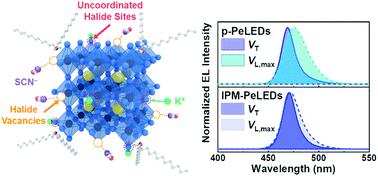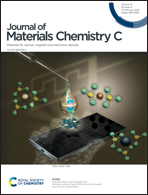Suppression of halide migration and immobile ionic surface passivation for blue perovskite light-emitting diodes†
Abstract
Cs-based perovskite nanocrystals (PeNCs) have been considered to be excellent emitters for perovskite light-emitting diodes (PeLEDs) due to their remarkable optoelectronic properties. Still, their poor optical properties are mainly attributed to the deeper defect states induced by the chlorine content, which has hampered the realization of the full potential of blue PeLEDs. Herein, we propose a surface passivation strategy by employing potassium thiocyanate, which is an immobile passivating material (IPM) that considerably improved the structure of the PeNCs by filling halide vacancies and uncoordinated halide sites. Indeed, the photoluminescence quantum yield of the IPM-introduced PeNCs was significantly enhanced to 74.1% compared to that of the reference PeNCs (34.0%). Besides, K+ seized the halide ions in the PeNCs, thereby resulting in excellent colloidal stability. Overall, the PeLEDs achieved an external quantum efficiency of 2.04% and an elongated operating lifetime. Our strategy provides a simple way for breaking down the hurdles limiting the practicability of PeLEDs in display applications.



 Please wait while we load your content...
Please wait while we load your content...